Mogilew
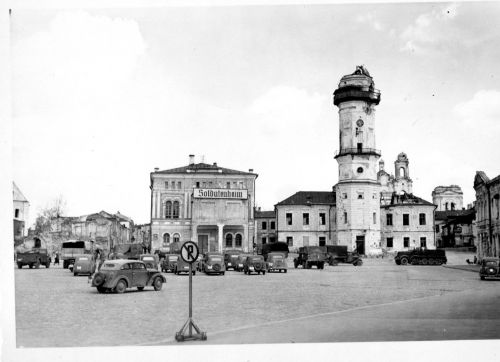
Mogilew Soldatenheim during the German occupation (Chris Webb Private Archive)
Mogilew is located 124 miles east of Minsk. According to the census of 1939, Mogilew's 19,715 Jews accounted for 19.8% of the city's population. The German invasion of the Soviet Union prompted the evacuation to the east of a considerable number of Jews combined with the conscription of part of the male Jewish population into the Red Army. The exact number of Jews remaining in Mogilew at the start of the occupation is estimated at circa 7,500.
Units of the Wehrmacht entered Mogilew on July 26, 1941. Mogilew was at first located in Panzer Group 2's zone of operations and then came under Rear Area Army Group Centre. Administrative authority in the city was divided between the local commandant's office (Ortskommandantur) 1/292 under Major Krantz, and the Field Commandant's office - Feldkommanantur 191, under Oberst Jatschwitz, with the former subordinate to the latter. Later they were replaced by Ortskommandantur 1/843, Ortskommandantur 1/906 and Feldkommanantur 813.
In the very first days of the occupation, the German authorities imposed a number of restrictions on the Jews of Mogilew, including a curfew, markings on their clothing- a yellow Star of David, and forced labour obligations. Also a Jewish Council (Judenrat) was established during August 1941.
The Germans conducted a census which registered 6,437 Jews, among whom were 2,090 children under the age of 15, it is thought that the number of Jews was actually higher, as some Jews either avoided registration or registered under an assumed identity. The Judenrat was forced to take an active part in implementing this measure. The German authorities then used this information to prepare the lists of people they wanted to execute in the future. The Jews were divided into three categories. In the first group were those considered capable of heading up a resistance movement or becoming active participants in the anti-Fascist struggle. They were executed first, with 80 Jews being killed during August 1941, by members of Einsatzkommando 8 under Dr. Otto Bradfisch. Among the victims were Party workers Astrov and Khavkin, plus business manager Rozenberg.
The second category included the bulk of the Jewish population, which initially had been subjected to confinement in an isolated area. On August 13, 1941, a notice appeared, signed by the head of the city authority, Mayor Felitsin: 'By order of the Herr Kommandant of the city of Mogilew, all persons of Jewish nationality, both genders, are to leave the city limits within 24 hours and relocate to the Ghetto zone. All persons failing to comply with the stated order in the stated period of time will be forcibly moved by the police and the property of those people will be confiscated.'
The Jews of Mogilew were herded into the ghetto on Grazhdanskaia Street in the Podnikol'e quarter. Jews from Kniazhitsy and the Vorotyn areas were also relocated here. In September 1941, the ghetto was moved to the bank of the River Dubrovenka, and its borders ran from Bykovskii Market to Vilenskaia Street. Mayor Felitsin selected the territory for the ghetto. A small number of Jews chose to leave Mogilew, rather than relocating to the designated ghetto area.
Confinement to the ghetto was accompanied by the murder of Jews as well. Jews were shot on the doorstep of their own homes. According to a German Security Police report, 'In Mogilew, the Jews also tried to sabotage their resettlement into the ghetto. One hundred and thirteen Jews were liquidated.'
Between 40 and 60 people were forced into each house in the ghetto on the River Dubrovenka bank. Foodstuffs were not provided. Jews were forbidden to leave the ghetto, which was a 'closed ghetto,' which was guarded by members of the Feldgendarmerie and Belorussian policemen. All those who were capable of work were sent to do physical labour. Young people were regularly beaten, while old men were mocked and their beards and mustaches were shorn.
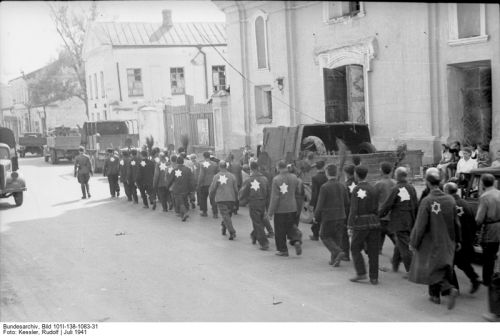
Mogilew - Jews marching out to perform hard labour (Bundesarchiv)
The shootings of Jews was almost continuous. Accused of impertinent behaviour, 337 Jewish women were shot. Two Jews were shot because they were not wearing the yellow Star of David badge. Another two were shot as it was alleged they were members of the People's Commissariat of Internal Affairs (NKVD). Three Jews were shot after being discovered with explosive material, and four for refusing to work. Eight Jews were accused of incitement and propaganda and they too were shot and killed.
According to several sources, besides the ghetto by the River Dubrovenka, there were other places for concentrating the Jews of Mogilew, which were established during September and October 1941, on Vilenskaia Street and in an enclosed part of a field, next to where the Hotel Mogilew stands today. These should be classified as holding places for victims, before they were executed. For longer periods of confinement, the Dimitrov Factory was used.
During September 1941, an experimental gassing of more than 500 mentally-ill patients was conducted by Artur Nebe, commander of Einsatzgruppen B, assisted by Dr. Albert Widman, a chemist from the Criminal Technology Institute in Berlin. Dr. Widmann described the events in detail:
'During the afternoon, Nebe had the windows bricked in, leaving two openings for the gas hose. When we arrived one of the hoses that i had brought was connected. It was fixed onto the exhaust of a touring car. Pieces of piping stuck out of holes made in the wall, onto which the hose could be easily fitted. After five minutes Nebe came out and said that nothing appeared to have happened. After eight minutes he had been unable to detect any result and asked what should be done next.
Nebe and I came to the conclusion that the car was not powerful enough. So Nebe had the second hose fitted onto a transport vehicle, which belonged to the regular police. It then took only another few minutes before the people were unconscious. Both vehicles were left running for about another ten minutes.'
The above led to the development of using gas-vans and the use of vehicle engines to gas untold numbers of victims in static chambers, at the death camps at Belzec, Sobibor and Treblinka in the Generalgouvernement during 1942 and 1943.
During October 1941, the Germans carried out two 'Aktions' aimed at the destruction of the ghetto on the bank of the River Dubrovenka. The first mass killing took place on October 2 and 3, 1941. The executioners were members of Einsatzkommando 8, Police Battalions 316, and 322. Ukrainian Schutzmannschaft Battalion 51, and a police detachment called 'Waldenburg.' In all 2,073 Jews were shot and killed. The first sixty-five Jews were killed on the spot in the ghetto on October 2, 1941. The remaining 2,008 people were first driven into the Dimitrov Factory, and then shot on October 3, 1941, in the Mashekovskii Jewish cemetery.
The second 'Aktion' was carried out on October 19, 1941. Members of Einsatzkommando 8, Police Battalion 316, and Ukrainian Schutzmannschaft Battalion 51, all participated in the 'Aktion.' This mass shooting claimed the lives of 3,726 Jews, took place predominantly in the villages of Kazimirovka and Novoe Pashkovo.
Between the 23-25 October 1941, Heinrich Himmler visited Mogilew where he inspected the labour camp established at the Dimitrov Factory. He was accompanied by a party of eight other gentlemen, one of whom was SS-Gruppenfuhrer Rudolf Querner, the Higher SS and Police Leader Nordsee.
In Mogilew, the Germans also used mobile gas -wagons to murder some of their victims. This instrument of death looked like a large, black -coloured enclosed truck. They killed people by feeding the vehicles own exhaust fumes into the hermetically sealed chamber, where the victims were incarcerated.
After the liquidation of the ghetto on the River Dubrovenka bank, remaining Jewish property there was plundered. The deserted homes were combed in the search for hidden valuables, high quality clothing, and household objects. The destruction of the ghetto on the River Dubrovenka bank marks the end of what is conventionally seen as the first phase in the history of the Holocaust in Mogilew.
It should be noted that the second phase is less clear and more problematic in terms of re-constructing events regarding the fate of the Jews who belonged to the third category drawn up by the Nazis after the census. At issue here are the specialist workers and craftsmen whom the Nazis needed, and they were therefore spared from liquidation until later. The saddlers, shoemakers, locksmiths, blacksmiths, carpenters, tailors, tinsmiths, tanners, glaziers, and painters, who were selected to live and were confined on the premises of the Dimitrov Factory. At the end of September 1941, approximately 1,000 Jews were incarcerated into the forced labour camp established there.
At the beginning of its existence, the camp probably was filled only with Jews and was a kind of a 'closed ghetto' for those performing hard forced labour, which also boasted of its own 15-man Jewish police force. It was guarded externally by local police, and the Jews were forbidden to leave its premises. According to the testimony of L.M. Naimark, after the liquidation of the ghetto on the River Dubrovenka bank, a considerable number of Jews were taken to the Dimitrov Factory and murdered there.
Work for the camp's Jewish inmates consisted of hard physical tasks, the inhabitants were fed poorly. Every Sunday, the Germans carried out a purge. The corpses were buried in two pits, right where they were shot. A typhus epidemic also broke out, as a result of the unsanitary conditions and terrible overcrowding.
Following the visit by Heinrich Himmler on October 23, 1941, the camp was expanded. According to witness testimony it was estimated that the capacity of the camp was approximately 2,000 people. During its existence between the autumn of 1941, and the autumn of 1943, up to 4,000 people probably passed through the camp, most of whom were killed. Sometimes contingents of Jews from elsewhere were sent to Mogilew. For example, approximately 400 Jews were brought to the camp from Slonim on May 26, 1942. Survivors have testified that up to 4,000 Jews were liquidated in the camp in a single 'Aktion' but the exact date is not known.
To cover up the traces of their crimes the Germans in the autumn of 1943, exhumed their victims remains from the mass graves in Polykovichi, Novoe Pashkovo, and Kazimirovka and burned them. A small number of Jews survived to see the liberation of Mogilew on June 28, 1944.Whilst the exact figure may never be known, it is estimated that some 14,000 Jews lost their lives.
Mogilew - Images
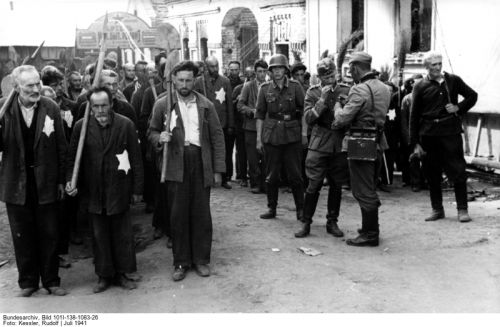
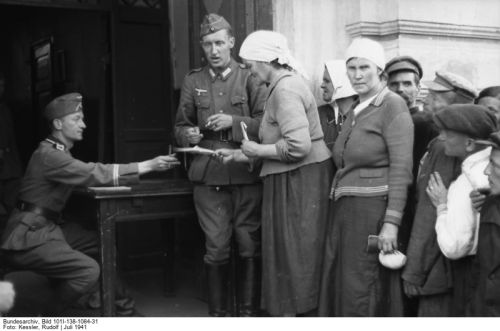
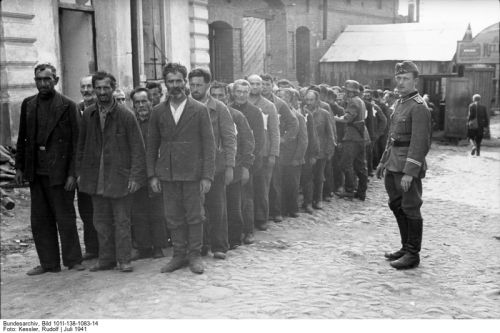

Mogilew - Jewish Workers (Bundesarchiv)
Sources
Encyclopaedia of Camps and Ghettos 1933- 1945, USHMM, Indianna University Press Bloomington and Indianapolis 2012
www. deathcamps.org -online resource
Photographs- Chris Webb Private Archive, Bundesarchiv
© Holocaust Historical Society 2019

